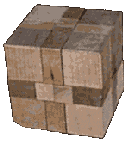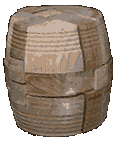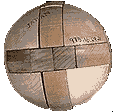It is thought that solid object puzzles were developed as early as the 18th century and may have come to Europe from the Orient. Several puzzles of this type were manufactured in 19th century Europe and after the 1930s by Japanese manufacturers. The first 4 puzzles pictured on this Webpage are from Japan. The fifth one is from the United States.
Constructed of a number of interlocking wooden pieces, at first the object appears to be impossible to take apart; however, one piece - known as the Key Piece - when removed, enables a user to take the object apart. For more information about these puzzles see:
Jerry Slocum & Jack Botermans, Puzzles Old & New, Seattle: University of Washington Press, 1987, page 63; and
Peter van Delft & Jack Botermans, Creative Puzzles of the World, New York: Harry N. Abrams, Inc., 1971, page 66.
 |
Box Puzzle This puzzle is composed of 16 notched wooden pieces which when assembled correctly form a box that is 5.8cm square. |
 |
Barrel Puzzle This puzzle is composed of 14 notched wooden pieces which when assembled correctly form a barrel shape that is 5.8cm high x 5cm in diameter. |
 |
Ball Puzzle This puzzle is composed of 8 notched wooden pieces which when assembled correctly form a ball that is 6.5cm in diameter. |
 |
Octagon Puzzle This puzzle is composed of 20 notched wooden pieces which when assembled correctly form an octagon that is 6cm high x 6cm in diameter. |
Hershey's Kiss Puzzle: This puzzle was purchased by the Museum from the Hershey Chocolate Factory in Pennsylvania in 1981. The puzzle is designed to represent a Chocolate Kiss - a Hershey's confection that has been popular for more than 50 years in the United States. A piece of the candy is solid milk chocolate and is only about 1.5cm at its base and is an inverted cone in shape.
Simulating a "real" Chocolate Candy Kiss, the puzzle is foil wrapped, and has a strip of white paper extending from the cover. The interlocking puzzle itself is composed of 15 plastic pieces which have internal holes and pegs. When assembled correctly the pieces form a shape that is 8cm in diameter at the base and 9cm high.
NOTE: This page was originally created and posted on the Web on October 6, 1997. Subsequently it has been modified and periodically updated. Last update April 7, 2010